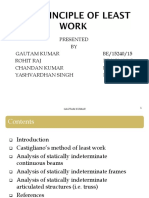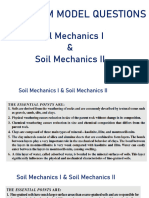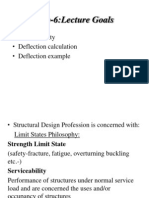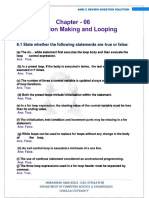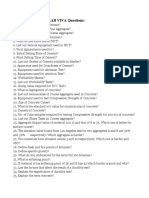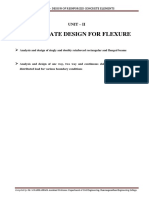Relationship Between Shear Force Bending Moment Intensity of Loading W
Relationship Between Shear Force Bending Moment Intensity of Loading W
Uploaded by
vik03223Copyright:
Available Formats
Relationship Between Shear Force Bending Moment Intensity of Loading W
Relationship Between Shear Force Bending Moment Intensity of Loading W
Uploaded by
vik03223Original Description:
Original Title
Copyright
Available Formats
Share this document
Did you find this document useful?
Is this content inappropriate?
Copyright:
Available Formats
Relationship Between Shear Force Bending Moment Intensity of Loading W
Relationship Between Shear Force Bending Moment Intensity of Loading W
Uploaded by
vik03223Copyright:
Available Formats
$3.
Shearing Force and Bending Moment Diagrams
49
Since the last answer can be ignored (being outside the beam), the point of contraflexure must be situated at 1.96m to the right of C .
3.6. Relationship between shear force Q, bending moment M and intensity of loading w
Consider the beam AB shown in Fig. 3.10 carrying a uniform loading intensity (uniformly distributed load) of w kN/m. By symmetry, each reaction takes half the total load, i.e., wL/2.
A
WL 2
Fig. 3.10.
EL
2
The B.M. at any point C , distance x from A , is given by
M
= -x - ( w x ) W L
i.e. Differentiating, Now
M = ~ W L-3.1. X dM --=+wL-wx dx
S.F. at C = 4 w L - wx
--
=Q
(3.1)
..
Differentiating eqn. (3.1),
dM dx
-Q
(3.3)
9- -w
dx
These relationships are the basis of the rules stated in the summary, the proofs of which are as follows: (a) The maximum or minimum B.M. occurs where d M / d x = 0 dM ----=Q But dx Thus where S.F. is zero B.M. is a maximum or minimum. (b) The slope of the B.M. diagram = d M / d x = Q. Thus where Q = 0 the slope of the B.M. diagram is zero, and the B.M. is therefore constant. (c) Also, since Q represents the slope of the B.M. diagram, it follows that where the S.F. is positive the slope of the B.M. diagram is positive, and where the S.F. is negative the slope of the B.M. diagram is also negative. (d) The area of the S.F. diagram between any two points, from basic calculus, is
You might also like
- The Principle of Least Work PDFDocument17 pagesThe Principle of Least Work PDFGautam100% (1)
- Cte McqsDocument18 pagesCte McqsSanjay ShewaleNo ratings yet
- Multiple-Choice Test Runge-Kutta 4th Order Method: y X Xy DX DyDocument3 pagesMultiple-Choice Test Runge-Kutta 4th Order Method: y X Xy DX DyDr Razak Olusegun Alli-Oke100% (1)
- Comparison of Kennedy's and Lacey's TheoriesDocument1 pageComparison of Kennedy's and Lacey's TheoriesneelNo ratings yet
- II Structural Analysis Unit 4 1Document28 pagesII Structural Analysis Unit 4 1J.R. EnginnerNo ratings yet
- P&B m1Document5 pagesP&B m1Andrizal ChaidarNo ratings yet
- Assignment - #2 GeotechDocument16 pagesAssignment - #2 GeotechÅbhîshęķ ĂryąNo ratings yet
- Lecture 200999Document22 pagesLecture 200999Sidney MusondaNo ratings yet
- Problem Set (GD)Document4 pagesProblem Set (GD)yadoleNo ratings yet
- Civil Engineering TRB Study Materials (Mechanics)Document99 pagesCivil Engineering TRB Study Materials (Mechanics)Anitha Muthukumaran63% (8)
- Farm Structure and Surveying Complete Compiled Note by PadamDocument441 pagesFarm Structure and Surveying Complete Compiled Note by Padamsubodhpaudel321No ratings yet
- Unit-II CurvesDocument42 pagesUnit-II CurvesPRAVIN KHANDVENo ratings yet
- Soil Mechanics and FoundationDocument64 pagesSoil Mechanics and Foundationmir imran100% (1)
- Earthwork Volume by Simpson's Rule - Civil Engineering Applications and Tips PDFDocument2 pagesEarthwork Volume by Simpson's Rule - Civil Engineering Applications and Tips PDFDivina Teja Rebanal-Glino100% (2)
- Unit 2 Questions With AnswerDocument3 pagesUnit 2 Questions With Answeranish100% (1)
- Exit ExamDocument64 pagesExit ExamTadesse MegersaNo ratings yet
- Geotechnical Engineering GATE Previous QuestionsDocument35 pagesGeotechnical Engineering GATE Previous QuestionsSurya ChejerlaNo ratings yet
- Chap 2Document47 pagesChap 2Amanu WorkuNo ratings yet
- Unit II: Analysis of Bars of Varying Cross SectionsDocument15 pagesUnit II: Analysis of Bars of Varying Cross Sectionsermias0% (1)
- Mix Design QnsDocument2 pagesMix Design QnsGaddam SudheerNo ratings yet
- Obstacles in ChainingDocument35 pagesObstacles in ChainingMadhav D NairNo ratings yet
- Railway Curves 7Document21 pagesRailway Curves 7vpmohammedNo ratings yet
- Civil Engineering Important MCQ PDF-Hydraulics and Fluid Mechanics Part 3 - WWW - ALLEXAMREVIEW.COMDocument10 pagesCivil Engineering Important MCQ PDF-Hydraulics and Fluid Mechanics Part 3 - WWW - ALLEXAMREVIEW.COMMuhammad WaqarNo ratings yet
- Matrix M of SA QuestionsDocument14 pagesMatrix M of SA Questionsrajivkannan100% (1)
- Lecture - Force MethodDocument73 pagesLecture - Force MethodF FNo ratings yet
- Theory of Elasticity and Plasticity Model QuestionsDocument2 pagesTheory of Elasticity and Plasticity Model Questionsrameshbabu_1979No ratings yet
- Part I: Multiple Choice Objective Type QuestionsDocument2 pagesPart I: Multiple Choice Objective Type QuestionsSridhar ProductivityNo ratings yet
- Hardened ConcreteDocument33 pagesHardened Concretechicku_iway100% (1)
- Route TD For All Student Learner's Highway EngineeringDocument25 pagesRoute TD For All Student Learner's Highway Engineeringkrishy19sNo ratings yet
- Tensile Strength of Good Quality BricksDocument21 pagesTensile Strength of Good Quality BricksFiaz Gujjar100% (1)
- Temperature StressesDocument38 pagesTemperature StressesMohamed MuayidNo ratings yet
- C. K. Pithawala College of Engineering & Technology: New-Mark's Influence Chart Westergaard's Formula, Contact PressureDocument14 pagesC. K. Pithawala College of Engineering & Technology: New-Mark's Influence Chart Westergaard's Formula, Contact PressureParth AnajwalaNo ratings yet
- Gravity Ropeway: "Ropes of Hope"Document17 pagesGravity Ropeway: "Ropes of Hope"Ramesh BalaNo ratings yet
- Assignment Solutions 5Document5 pagesAssignment Solutions 52020CEM029 MUJEEBUL100% (1)
- Drainage and Drainage StructuresDocument20 pagesDrainage and Drainage StructuresJiregna ChalchisaNo ratings yet
- W18 TOS Official Paper and Model Answer Paper 22402Document18 pagesW18 TOS Official Paper and Model Answer Paper 22402irshadmirza753No ratings yet
- MCQs On Concrete TechnologyDocument88 pagesMCQs On Concrete TechnologyDishantsingh RajputNo ratings yet
- Chapter 6Document21 pagesChapter 6Shida ShidotNo ratings yet
- Vibration Analysis - Approximate Methods: Unit 4 - ContinuationDocument29 pagesVibration Analysis - Approximate Methods: Unit 4 - ContinuationAdrian ArasuNo ratings yet
- What Are The Characteristics of ContoursDocument1 pageWhat Are The Characteristics of ContoursAnkush Pendhari0% (1)
- Hawassa University: Department of Hydraulic and Water Resources EngineeringDocument2 pagesHawassa University: Department of Hydraulic and Water Resources EngineeringAmanuel AlemayehuNo ratings yet
- Highway Curves NoteDocument47 pagesHighway Curves NoteHarish joshiNo ratings yet
- Force (Flexibility) Method of Structural AnalysisDocument48 pagesForce (Flexibility) Method of Structural AnalysisthareendaNo ratings yet
- Angularity Number Test: Sushrut Gautam KCE074BCE089 Transportation Engineering II Khwopa College of EngineeringDocument5 pagesAngularity Number Test: Sushrut Gautam KCE074BCE089 Transportation Engineering II Khwopa College of EngineeringSushrutNo ratings yet
- 425 Serviceability CHP 6 S11Document76 pages425 Serviceability CHP 6 S11aomareltayeb100% (1)
- RC I Questions For TutoarialDocument15 pagesRC I Questions For Tutoarialletaabera2016No ratings yet
- E Balagurusamy CH 6 SolutionDocument18 pagesE Balagurusamy CH 6 SolutionPriya BhavsarNo ratings yet
- Articulate StructuresDocument2 pagesArticulate StructuresHari PrasadNo ratings yet
- Frequency of Free Damped Vibrations (Viscous Damping)Document8 pagesFrequency of Free Damped Vibrations (Viscous Damping)ذوالفقار علي حسينNo ratings yet
- Conjugate Beam MethodDocument12 pagesConjugate Beam MethodAmitNo ratings yet
- Soil Stress Total Stress, Pore Pressure, U Effective Stress, 'Document7 pagesSoil Stress Total Stress, Pore Pressure, U Effective Stress, 'Nala A.No ratings yet
- LAB VIVA QuestionsDocument4 pagesLAB VIVA QuestionsKh Bappi ShahriarNo ratings yet
- MCQ Steel StructuresDocument52 pagesMCQ Steel StructuresCheran pandian SNo ratings yet
- Unit II - Limit State Design For FlexureDocument8 pagesUnit II - Limit State Design For FlexureManikandan100% (1)
- Structure Detailing Lab ManualDocument27 pagesStructure Detailing Lab Manualkelmazodro100% (1)
- Numerical Methods and Implementation in Geotechnical Engineering – Part 1From EverandNumerical Methods and Implementation in Geotechnical Engineering – Part 1No ratings yet
- Shear Fand Bendi DiagramsDocument9 pagesShear Fand Bendi Diagramsk.ghanemNo ratings yet
- Shearing Force and Bending Moment Diagrams: S.F. B.M. ForDocument1 pageShearing Force and Bending Moment Diagrams: S.F. B.M. Forvik03223No ratings yet
- Strength of Materials - Lec03Document20 pagesStrength of Materials - Lec03Dheyaa Al-JubouriNo ratings yet
- 2a. SF&BM Numerical ProblemsDocument10 pages2a. SF&BM Numerical ProblemsMike chibaleNo ratings yet
- D 2 y M - EX: Slope and Dejection of BeamsDocument1 pageD 2 y M - EX: Slope and Dejection of Beamsvik03223No ratings yet
- Slope and Dejection Of: X X X Dy DX X Dy DXDocument1 pageSlope and Dejection Of: X X X Dy DX X Dy DXvik03223No ratings yet
- Slope and Defection of Beams: KN 2 0 K N KNDocument1 pageSlope and Defection of Beams: KN 2 0 K N KNvik03223No ratings yet
- Slope and Defection of Beams: Fig. 5.24. Maxwell's Theorem of Reciprocal DisplacementsDocument1 pageSlope and Defection of Beams: Fig. 5.24. Maxwell's Theorem of Reciprocal Displacementsvik03223No ratings yet
- 116 Mechanics Materials g5.11Document1 page116 Mechanics Materials g5.11vik03223No ratings yet
- 12 - Page 137 PDFDocument1 page12 - Page 137 PDFvik03223No ratings yet
- Mechanics: 5.8. Principle of SuperpositionDocument1 pageMechanics: 5.8. Principle of Superpositionvik03223No ratings yet
- 12 - Page 140 PDFDocument1 page12 - Page 140 PDFvik03223No ratings yet
- 5.7 Slope and Deflection of Beams: (C) Simply Supported Beam With U.D.LDocument1 page5.7 Slope and Deflection of Beams: (C) Simply Supported Beam With U.D.Lvik03223No ratings yet
- 12 - Page 136 PDFDocument1 page12 - Page 136 PDFvik03223No ratings yet
- D2y dx2 Dy: Mechanics of MaterialsDocument1 pageD2y dx2 Dy: Mechanics of Materialsvik03223No ratings yet
- Mechanics Materials Solution: X X X X XDocument1 pageMechanics Materials Solution: X X X X Xvik03223No ratings yet
- Fig. 4.14. Eccentric Loading of Rectangular Sections-"Middle Third"Document1 pageFig. 4.14. Eccentric Loading of Rectangular Sections-"Middle Third"vik03223No ratings yet
- 12 - Page 138 PDFDocument1 page12 - Page 138 PDFvik03223No ratings yet
- Mechanics of Materials: ProblemsDocument1 pageMechanics of Materials: Problemsvik03223No ratings yet
- Slope Deflection of Beams: y (Or Dy DX D 2 y EI dx2 D 3 y EI-dx3 D4y EI - dx4Document1 pageSlope Deflection of Beams: y (Or Dy DX D 2 y EI dx2 D 3 y EI-dx3 D4y EI - dx4vik03223No ratings yet
- Slope Deflection of Beams: (A) Deflection Positive UpwardsDocument1 pageSlope Deflection of Beams: (A) Deflection Positive Upwardsvik03223No ratings yet
- Lo6 Io: Mechanics of MaterialsDocument1 pageLo6 Io: Mechanics of Materialsvik03223No ratings yet
- 12 - Page 122 PDFDocument1 page12 - Page 122 PDFvik03223No ratings yet
- 5.7. Mohr's "Area-Moment" Method: B.M. DiagramDocument1 page5.7. Mohr's "Area-Moment" Method: B.M. Diagramvik03223No ratings yet
- 12 - Page 96 PDFDocument1 page12 - Page 96 PDFvik03223No ratings yet
- 12 - Page 128 PDFDocument1 page12 - Page 128 PDFvik03223No ratings yet
- 5.1 Continuous Beams-Clapeyron's "Three-Moment" Equation: Slope and Deflection BeamsDocument1 page5.1 Continuous Beams-Clapeyron's "Three-Moment" Equation: Slope and Deflection Beamsvik03223No ratings yet
- 85.1 Slope and Deflection of Beams 6x: l/EZ 1/EZDocument1 page85.1 Slope and Deflection of Beams 6x: l/EZ 1/EZvik03223No ratings yet
- 12 - Page 109 PDFDocument1 page12 - Page 109 PDFvik03223No ratings yet
- Mechanics of Materials: or orDocument1 pageMechanics of Materials: or orvik03223No ratings yet
- Slope Deflection Beams 6 A% L: and ofDocument1 pageSlope Deflection Beams 6 A% L: and ofvik03223No ratings yet
- Sbpe Ot: A Wirh Moment WithDocument1 pageSbpe Ot: A Wirh Moment Withvik03223No ratings yet
- 12 - Page 125Document1 page12 - Page 125vik03223No ratings yet
- Mechanics of Materials (D) Simply Supported Beam Central Concentrated LoadDocument1 pageMechanics of Materials (D) Simply Supported Beam Central Concentrated Loadvik03223No ratings yet
